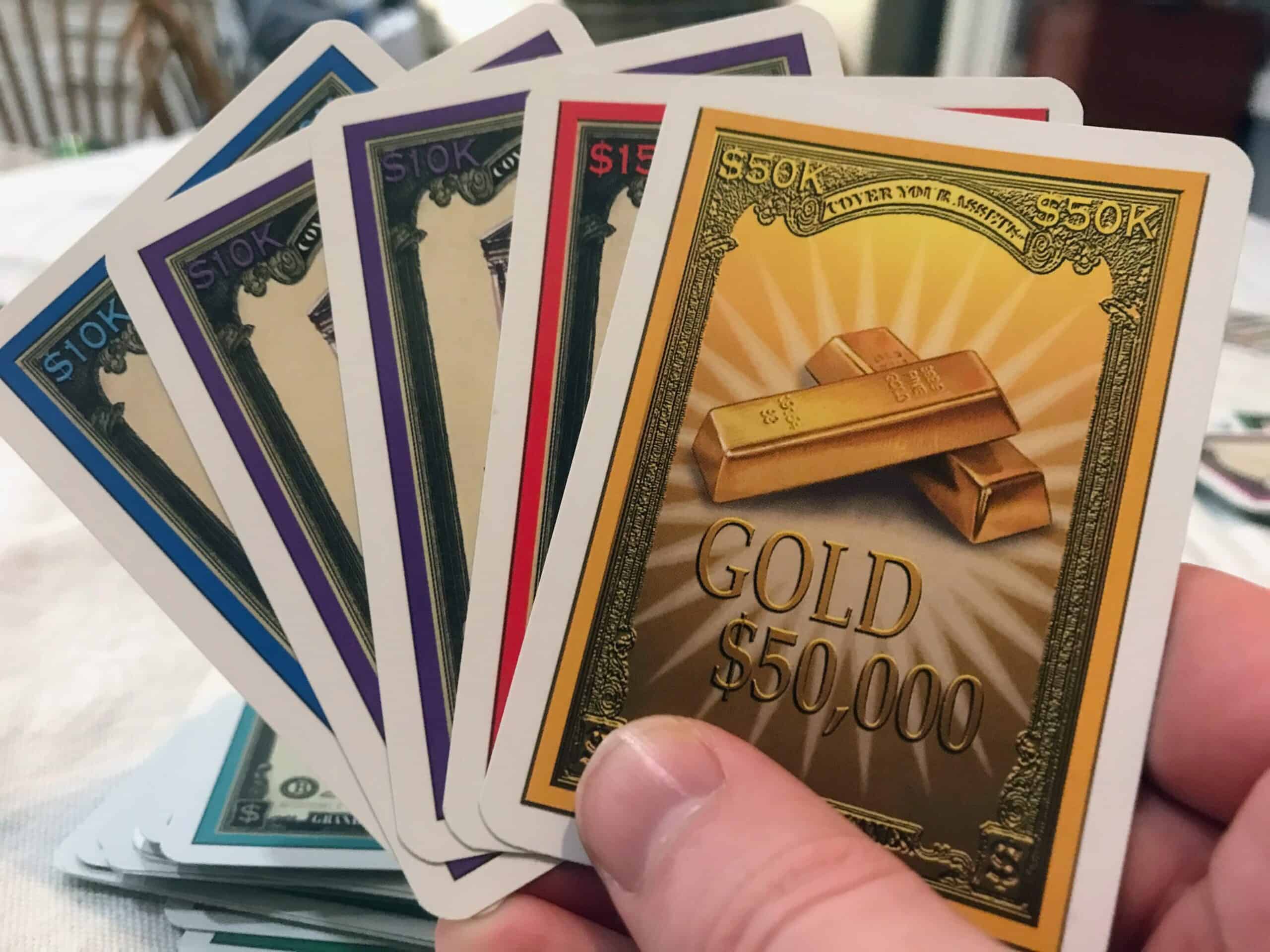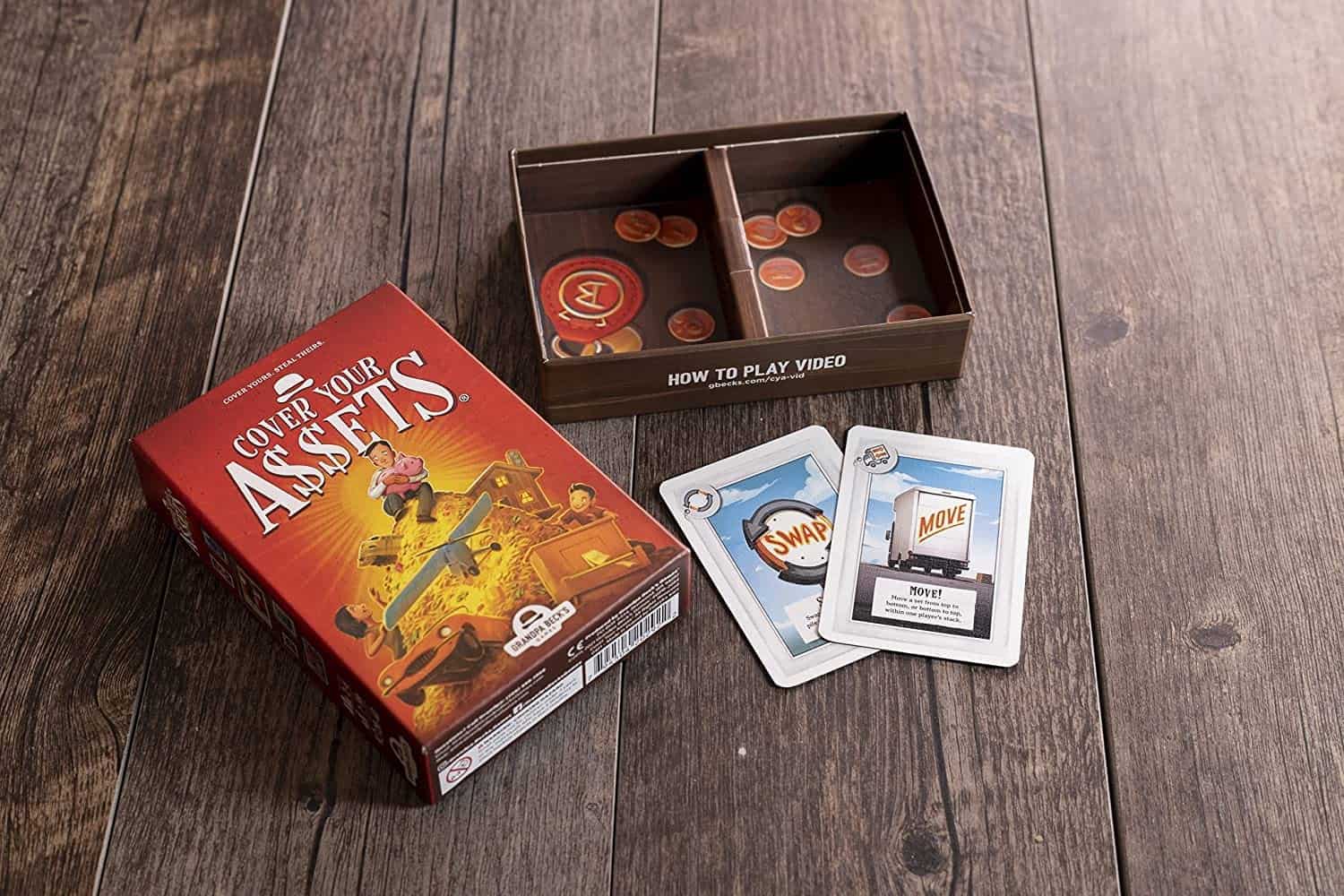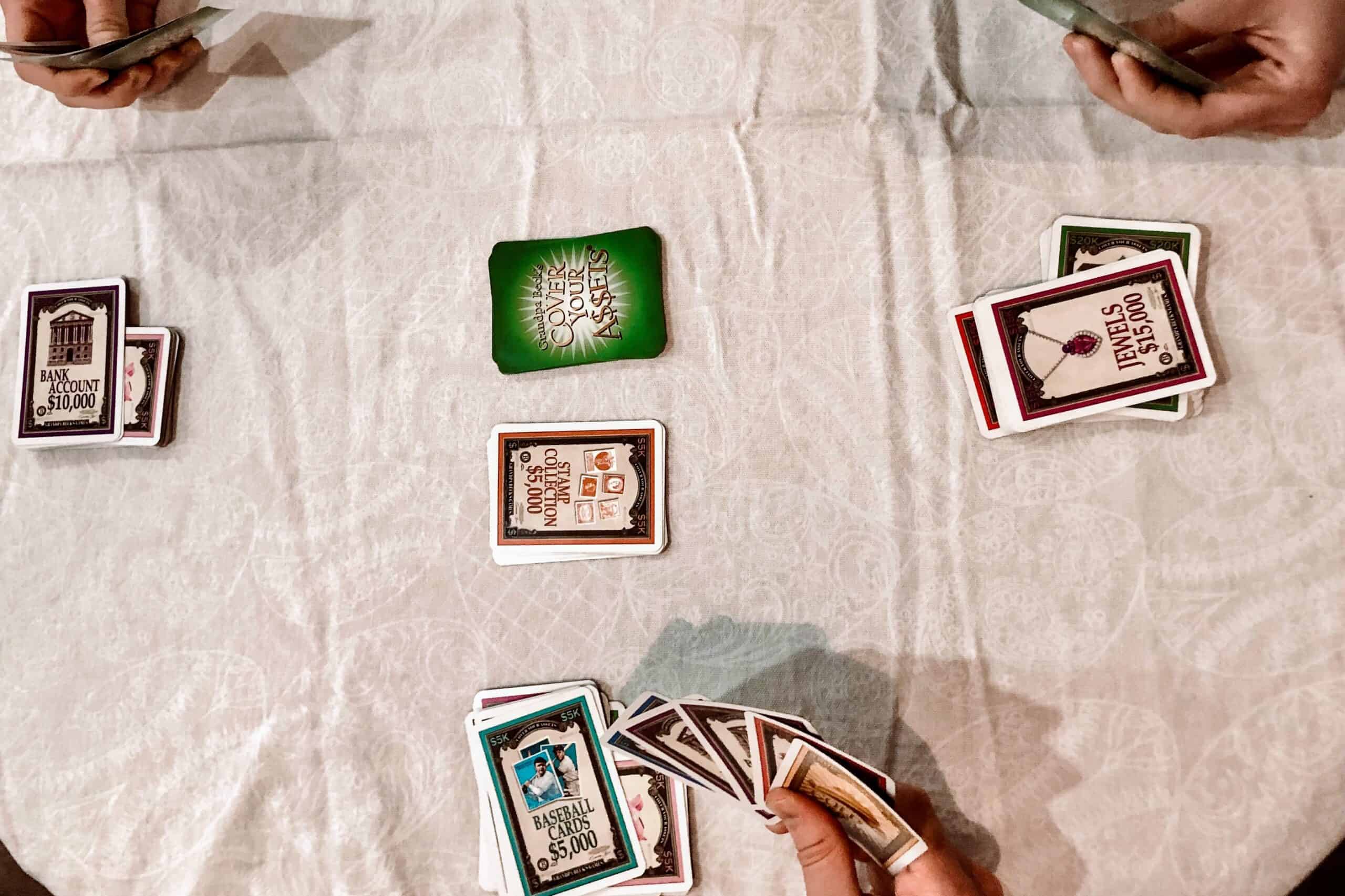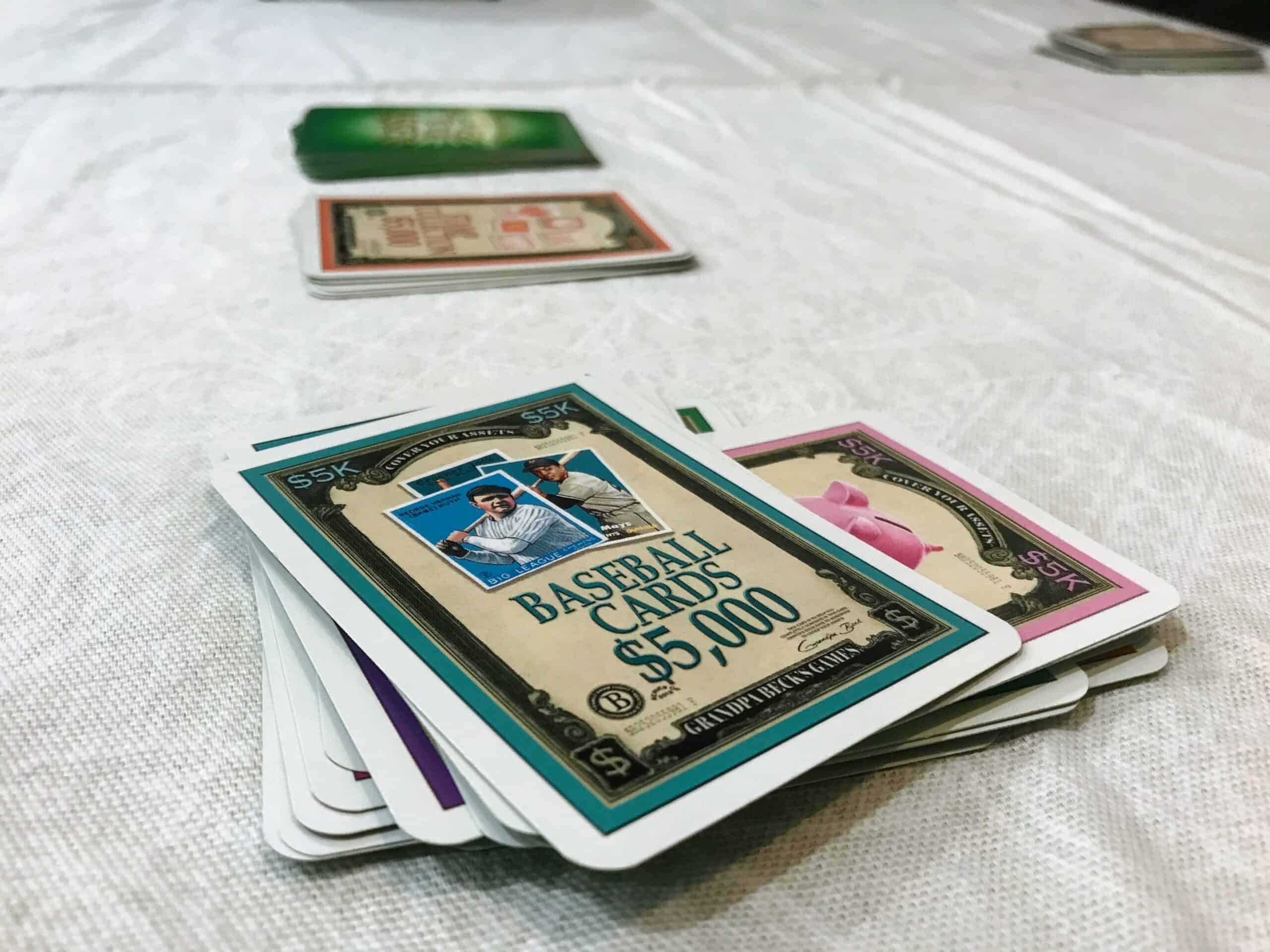Cover Your Assets is a card game created specifically for light-hearted gamers who like to fall out with each other. Experience the cut-throat world of business and collecting as your friends and family gang up on you, stab you in the back, defraud you, crush your dreams, and otherwise tear your carefully constructed fortune from your hands. Not for dysfunctional families. Monopoly has nothing.
That’s if you lose. Winners of this game will have a completely different take: they’d say it’s all about clever strategy, knowing when to strike, and, as the name suggests, protecting your assets.
In this game guide to Cover Your Assets, I’ll be talking about why I’ve enjoyed this game. I’ll also briefly go over the rules and explain why, despite being a relatively simple concept, it makes grown men cry.
Before You Begin

Cover Your Assets is all about protecting your pile of “asset” cards. You’ll only score for those on the table in front of you. However, that also means everyone else can see your cards. Their greedy eyes will slyly flick over in your direction, and you’ll suddenly realize with daunting fear that there’s no way you can stop them from getting their stinking paws on your $50,000. (Sorry, I’m still bitter from our last game.)
Ahem. Right.
You need at least four players for a game and a maximum of six. You can play with more (or less), but the game won’t work so well.
Set up the table by shuffling the two decks together and dealing out five cards (or four – but I’ll be assuming five for this article) to each player. Place the rest of the combined deck in the center and turn the top card over, placing it face-up at the side. This is the start of your discard pile.
The game contains the following 110 cards. These are made up of the 10 “assets”:
- Stamp Collection x10 – $5,000
- Cash Under The Mattress x10 – $5,000
- Baseball Cards x10 – $5,000
- Piggy Bank x10 – $5,000
- Stocks x10 – $10,000
- Coin Collection x10 – $10,000
- Bank Account x10 – $10,000
- Classic Auto x10 – $15,000
- Jewels x10 – $15,000
- Home x8 – $20,000
There are also 2 wildcards:
- Silver x8 – $25,000
- Gold x4 – $50,000
The aim is to reach $1,000,000 in total assets. Count each player’s scores at the end of each round. In my experience, it takes around four or five rounds before this point, when the game finishes.
How to Play

As usual, the player to the left of the dealer will start.
Each turn, every person has four options. They can’t choose to do nothing – every time it’s their turn to play, they must complete one (and only one) of the following:
- Make a pair with two identical asset cards from their hand.
- Make a pair using one card from their hand and the top card in the discard pile.
- Challenge another player in an attempt to steal their asset pair (more on that in a moment).
- Discard a card from your hand and pick the top one from the main deck.
At the end of each turn, you must replenish your hand back to five cards from the main deck (or however many you started with).
There are a few things to know at this point:
- You place assets in front of you in pairs. They can only be placed in pairs.
- You must stack pairs perpendicularly on top of each other. This makes them much easier to sort through and count but also assists other players in examining your portfolio.
- The first pair you place – known as your nest egg – is safe from other players’ challenges. (Therefore, it’s an excellent place to put expensive assets and wildcards.)
- You can’t place two wildcards together to make a pair – they must always couple another asset.
- If you place a wildcard down after the first turn, it’s a good idea to do it subtly by tucking it squarely behind the other asset. This might hide it from other players if you can do it inconspicuously enough.
- The discard pile might sometimes be empty – that’s okay, just leave it. Eventually, someone will place a card down, and it’ll resume. Don’t turn the top card of the deck over to force the pile into existence.
Now, let’s consider each of these options in more detail.
Making a Pair From Cards in the Hand

If you have two identical cards in your hand, you can place them together on the table in front of you. As mentioned above, your first pair is safe from opponents’ challenges.
Note that if you have three asset cards of the same type in your hand, you can’t play them as a triplet. Make a pair as usual and keep the other in your hand.
That’s all there really is to this move! Nice and simple. Take two cards from the main deck to replenish your hand at the end of your turn.
Making a Pair Using the Discard Pile
If a card in your hand matches the top card in the discard pile, you can place the two down as an asset pair in your stack.
It’s a particularly good idea to do this even if you already have a pair of the same type in your hand. This will give you some measure of protection against anyone trying to steal your newly-played asset.
Since this move will require only one card from your hand, draw one asset from the top of the main deck.
Challenging for Another Player’s Top Assets

Let’s take a moment to pause and reflect here, remembering all the friendships and relationships that didn’t survive these moves.
As the winner of the challenge, you’ll take great glee in the loser’s suffering. However, as the loser, you’ll become tunnel-visioned and do anything you can to seize those assets (or get them back) or generally make the other person’s day worse. Even if they’re just $5,000 Piggy Banks.
Despite my overdramatic opinions and lack of wins in this game, I enjoy it quite a lot. Challenging is the real point of the whole game.
So, here’s how to do it.
- You can only steal an opponent’s top asset pair. Everything in their stack under the top “layer” is safe (for now).
- You can also only challenge if you have at least one asset pair in your stack and your opponent has at least two. Remember, you can’t steal the bottom “nest egg”.
- To challenge, you’ll need another card of that same asset type in your hand. Wildcards can also be used.
- When it’s your go, place your card from your hand down on the table, and tell Player X that you’ll be challenging them for their top set.
- No doubt highly insulted, Player X can choose to defend their assets if they wish. Players protect their stack by placing more cards of the same type (or wildcards) on the table.
- This goes back and forth until one player simply runs out of cards (or voluntarily chooses to stop).
- Whoever placed the last card will win the challenge. Whoever this is will most likely perform some kind of action that can best be summed up by “sore winner”.
- All the asset cards played in the challenge are collected, combined, and added to the set, which gets placed on top of the winner’s stack. You can see how the values of these sets can add up pretty quickly.
At the end of the turn, every player must take the total number of cards in their hand back to five. This includes the opponent who was challenged. The player whose turn it was will draw their cards first.
You’ve successfully stolen your friend’s hard-earned assets. Congratulations! However, be aware that all the other players now know you have a precious set perched unprotected on the top of your stack. Be ready to fight off those scummy thieves, who will undoubtedly… wait, yes, do the exact same thing you did. Oh well. C’est la vie.
There’s no absolute “best” way to go about this move, although I’d say doing it earlier is better. After that, you can focus more on protection. This gives you more time to “cover your assets”, protecting them, as the game progresses. See why it’s called that now?
Discard and Draw
If none of the above moves float your boat – or you literally can’t go – you must discard a card of your choice. Place it face-up in the discard pile and draw a card from the top of the main deck.
That’s the end of your go. Even if you can use that new card as part of a set or to challenge, you’ll have to wait – and hope nothing changes.
Ending the Round

The game continues until all the cards in the deck are exhausted. At this point, players keep on taking their turns but, of course, can’t replenish their hands. If they can’t make a pair or challenge, they still have to discard an asset from their hand. Eventually, nobody will be able to take their turn, and the round ends.
Note that everything can change in the last couple of turns. If extremely unlucky and targeted by the other players, one player could lose almost everything in their stack.
Players must now count up the assets in their stacks. Count each card as an individual. For example, two $5,000 Stamp Collection cards would be worth $10,000 in total.
You’ll probably find a fairly significant difference between players’ scores. One might have $20,000 while your friend across the table has raked in a crazy $400,000. I’ve found this often happens. Not to worry – the tables could turn completely in the next round!
Keep on playing, counting up the scores at the end of each round until one of you reaches $1,000,000. That player is the winner – although they’re sure to win nothing more than angry glares from everyone else.
Tips to Know in Advance

To some extent, winning Cover Your Assets is down to the luck of the draw. If you happen to be able to lay down assets quickly, you can cover your high-value cards as thoroughly as possible. Making pairs pretty much comes through chance. That being said, if you suspect another player might be waiting for the opportunity to place an asset that you have, you can choose your next move. Either discard your card and steal their pair or hold onto it and try to challenge later on. There is some skill involved in this.
As I briefly touched on nearer the top of this page, when you start out, you should try to place the highest value asset pair you can. This is called your nest egg. These cards are safe from challenges, so it’s very worthwhile. The largest amount you can place in your nest egg is $70,000 (House – $20,000; and a Gold wildcard – $50,000). By contrast, the lowest value your nest egg can hold is $10,000 (two $5,000 assets). Although you should always aim for a high-value pair to start out, sometimes you’ll have to just place whatever you can get since you can’t start challenging until you have your nest egg on the table.
Common Mistakes to Avoid

The most common mistake to avoid is rashly going all-in during a challenge. Sometimes, it’s wiser to hold back, preparing to re-steal or protect your stack later in the game. Also, if you use all five cards in your hand to protect your asset, you’ll add enormous amounts to its value and find yourself with potentially no way to defend yourself from anyone else. It’s all about timing, really. Is now the right time to go all-in, or not? Every game is different, so you’ll have to make that decision in the moment.
Likewise, another mistake could be waiting too long to challenge. If you don’t act quickly enough, your opponent will start covering that valuable asset with as many pairs as they can get their hands on. This takes your target further and further out of reach.
Remember that the play can continue at the end of the game – even when you’ve run out of options and cards. You’ll have no way to defend a few assets. If other players are mean (and they most certainly will be), they’ll challenge you for all your assets when you have no way to defend. As such, try to spend the last few turns placing as many assets as possible on your stack – no matter where they come from.
Overall, from a gameplay point of view, the best tip would be to stop yourself from getting tunnel vision. Each turn, the table will change significantly. When it comes back round to your go, make the decision that will be most impactful at that moment, planning for the next few rounds. It’s pretty easy to overzealously target one player to try to steal their assets, but sometimes this isn’t the most logical move.
Finally, as my final – and definitely most important tip – don’t make everyone hate you! If you start out by stealing assets left, right, and center, your fellow players will take it personally. They just will. Before long, you’ll find yourself fighting challenges from all other 3 to 5 opponents, and they’ll all take great joy at your suffering and dismay. If you’re going to challenge (and you will need to if you want to win), don’t challenge any more than another player, so you can hide behind how much everyone hates them.
Conclusion

My honest opinion on Cover Your Assets is it’s a decent 7 out of 10 card game. The cards are nicely illustrated and easy to distinguish from each other with bright colors. Despite being heavily dependent on chance, it reminds me a little of high-stakes poker games – it’s luck, yes, but it’s how you manage that luck that comes into play.
Cover Your Assets isn’t for everyone, and I certainly wouldn’t play it too often. Many players might require a solitary walk for an hour or two to cool off after a competitive game. And, yes, they’re always intense.
Overall? A great game to whip out of there are a few of you wanting to spend half an hour of your evening on a card game. However, beware of flaring tempers, quiet rage, and floods of tears. A game for the winner to relish and the losers to loathe.
If you’d like to get yourself a copy of Cover Your Assets, you can find it at most Walmarts or on Amazon.
FAQs
Question: How much money is in Cover Your Assets?
Answer: Cover Your Assets contains 110 cards. There are ten of each of the nine lowest-value assets, eight Homes and Silver wildcards, and four Gold wildcards.
When these all get added up (which I’ve just double-checked – their individual values are listed at the top of this page), it comes to a total of $1,360,000 up for grabs in each round.
Of course, some of these cards will be discarded and therefore worthless to the final score. However, you can still reasonably expect at least $1,000,000 to be shared between all players each round.
Question: Who makes Cover Your Assets?
Answer: Cover Your Assets is made by Grandpa Beck’s games. The company also produces these other popular titles:
• Skull King
• Cover Your Kingdom
• Antiquity Quest
• Gnoming Around
• The Bears and the Bees
• Nuts About Mutts
Question: Do you have to discard in Cover Your Assets?
Answer: In Cover Your Assets, you only need to discard if you can’t do anything else – or you choose not to. You must discard one of your assets and take a new one from the draw pile.
Even when the deck is exhausted at the end of the game, you must still discard if you can’t otherwise go.
- Terraforming Mars Guide: Fighting for Spaces in Space - April 22, 2023
- Zathura Board Game Guide - April 20, 2023
- Ark Nova Guide – Zoo Complex, Or Complex Zoo? - April 8, 2023

